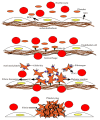The Role of Platelet Dysfunctions in the Pathogenesis of the Hemostatic-Coagulant System Imbalances
- PMID: 40141398
- PMCID: PMC11943152
- DOI: 10.3390/ijms26062756
The Role of Platelet Dysfunctions in the Pathogenesis of the Hemostatic-Coagulant System Imbalances
Abstract
Platelet dysfunction plays a critical role in the pathogenesis of various disorders affecting the hemostatic-coagulant system. This review aims to explore the mechanisms by which platelet dysfunctions contribute to the disruption of hemostasis, leading to an increased risk of both thrombosis and bleeding. Platelets, traditionally known for their role in clot formation, can exhibit altered functionality under pathological conditions such as cardiovascular diseases, metabolic disorders, and autoimmune diseases, impacting their interaction with coagulation factors and vascular endothelium. The review discusses the molecular and cellular mechanisms underlying platelet dysfunction, including aberrations in platelet activation, aggregation, and secretion. It also highlights the interplay between platelets and other components of the coagulation cascade, such as fibrinogen and clotting factors, in maintaining vascular integrity. Moreover, the review examines clinical implications, including how platelet dysfunction can be a contributing factor in conditions like deep vein thrombosis, stroke, and disseminated intravascular coagulation (DIC). Finally, current therapeutic approaches targeting platelet dysfunctions, including antiplatelet agents and emerging therapies, are reviewed to provide insights into potential strategies for managing fluid-coagulation system imbalances. This review underscores the importance of a comprehensive understanding of platelet dysfunction to improve diagnosis and treatment of hemostatic disorders.
Keywords: hemostasis; platelet dysfunction; the hemostatic-coagulant system; thrombosis.
Conflict of interest statement
The authors declare no conflict of interest.
Figures

Similar articles
-
Platelets are versatile cells: New discoveries in hemostasis, thrombosis, immune responses, tumor metastasis and beyond.Crit Rev Clin Lab Sci. 2016 Dec;53(6):409-30. doi: 10.1080/10408363.2016.1200008. Epub 2016 Jul 22. Crit Rev Clin Lab Sci. 2016. PMID: 27282765 Review.
-
Platelets and coagulation in thrombus formation: aberrations in the Scott syndrome.Thromb Res. 2016 May;141 Suppl 2:S12-6. doi: 10.1016/S0049-3848(16)30355-3. Thromb Res. 2016. PMID: 27207414 Review.
-
Thrombocytopathy leading to impaired in vivo haemostasis and thrombosis in platelet type von Willebrand disease.Thromb Haemost. 2017 Feb 28;117(3):543-555. doi: 10.1160/TH16-04-0317. Epub 2016 Dec 22. Thromb Haemost. 2017. PMID: 28004055
-
Novel mouse hemostasis model for real-time determination of bleeding time and hemostatic plug composition.J Thromb Haemost. 2015 Mar;13(3):417-25. doi: 10.1111/jth.12802. Epub 2015 Jan 9. J Thromb Haemost. 2015. PMID: 25442192 Free PMC article.
-
NLRP3 regulates platelet integrin αIIbβ3 outside-in signaling, hemostasis and arterial thrombosis.Haematologica. 2018 Sep;103(9):1568-1576. doi: 10.3324/haematol.2018.191700. Epub 2018 May 24. Haematologica. 2018. PMID: 29794149 Free PMC article.
References
Publication types
MeSH terms
LinkOut - more resources
Full Text Sources
Medical

